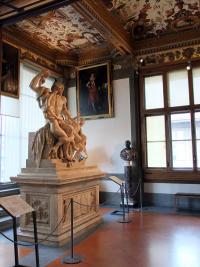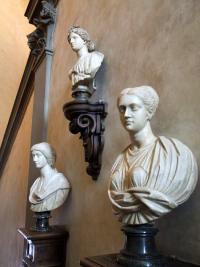THE UFFIZI — A TREASURE HOUSE OF ART
THE UFFIZI GALLERY, next to the Palazzo Vecchio, is one of the world's most important galleries. It provides a detailed overview of Florentine painting from the early to the late Italian Renaissance and holds major works from other periods and other countries.
THE BUILDING is shaped like a horseshoe. It was constructed between 1560-80 as offices (Uffizi is Italian for offices) for Duke Cosimo I of Tuscany. The Uffizi with its superbly frescoed ceilings was expensive to build, but Duke Cosimo had just become the ruler of Siena and wanted to show the world how wealthy and powerful Florence was.
Rooms are arranged chronologically, making it relatively easy to follow developments of style in the Renaissance. However, there are few story boards so it is worth buying the catalogue first or taking a private tour. This is Italy's premier art gallery, home of so many masterpieces it is mind-boggling. For this reason it is often very crowded and you are strongly advised to buy a timed ticket in advance.
GEORGIO VASARI, architect of the building, wrote that “I have never built anything more difficult nor more dangerous, since its foundations are on sand and over the river, almost in the air.†So Vasari used a cast iron framework to support the long windows overlooking the Arno. The windows panes were unusually large for the 16th century.
DUKE FRANCESCO I (Duke Cosimo's heir), aware that the Uffizi had excellent natural light, used its top floors to display Medici family treasures. The duke brought his favourite works from the Pitti Palace and the Medici Palace in Rome. He created a prestigious gallery of paintings and sculpture, which eventually would occupy the complete building.
Floods devastated Florence in the 1960s and a mixture of river water, heating oil and sewage entered through the long windows resulting in some damage to the building.
 THE MEDICI AS ART COLLECTORS. Many of the masterpieces collected by Cosimo the Elder, his son Pierro the Gouty, his grandson Lorenzo the Magnificent, Duke Cosimo I and his descendents are housed on the upper floors of the Uffizi. To see them means an exhausting climb up four long flights of stairs with widely spaced treads, which can be tiring for the elderly, but there is a lift for the disabled.
THE MEDICI AS ART COLLECTORS. Many of the masterpieces collected by Cosimo the Elder, his son Pierro the Gouty, his grandson Lorenzo the Magnificent, Duke Cosimo I and his descendents are housed on the upper floors of the Uffizi. To see them means an exhausting climb up four long flights of stairs with widely spaced treads, which can be tiring for the elderly, but there is a lift for the disabled.
All artworks owned by the Medici dynasty were donated to the people of Florence by the last of the dynasty, the childless Duchess Anna Ludovici. Duchess Anna died in 1743, happy in the knowledge that the next rulers of Florence, the Dukes of Lorraine (who were the closest surviving relatives of the Medici) could not send priceless Medici artworks to France where they spent part of their time.
The collection comprise ancient Greek and Roman sculptures, collected by Cosimo the Elder and his son, Piero the Gouty.
THE TRIBUNA. This central area can sometimes become overcrowded and it has be closed the press of people becomes so intense. The area displays favourite artworks of the Medici in a magnificent red and gold setting designed by Buontalenti. The colours of the décor symbolise the four elements — Fire, Earth, Air and Water. The red walls represents Fire, green marble represents Earth, white represents Air while blue represents the Ocean.
ON THE GROUND FLOOR of the Uffizi is a fascinating study area and small gallery where some of the world's finest collection of Old Master drawings are consulted by scholars from galleries and universities all over the world, with a small selection of Old Master drawings on display.
When author and art historian Susanna de Vries visited the study area as part of her Churchill Fellowship she found herself alongside Eric Hebborn, a clever forger of Old Master drawings, who six weeks later made the newspapers when Hebborn was found murdered in Rome.
THE VASARI GALLERY leads to the Vasari Corridor connecting the Uffizi with the Pitti Palace, Grand Duke Cosimo's home. Due to murders of members of the Medici, Duke Cosimo was worried about his safety and the Vasari Corridor enabled him to walk from his residence across the Arno in the Pitti Palace to his administrative offices, surrounded by henchmen and safe from assassination.
 A window opening onto the Council Chamber enabled the duke to eavesdrop on council meetings. The Vasari Gallery crosses the Arno River high above the Ponte Veccio. On the walls of this passage-like gallery hang self-portraits of great artists from all over Europe. One of the most interesting the self portrait of young Raphael, pale and delicate, who would die young, before his remarkable talents reached the peak of achievement.
A window opening onto the Council Chamber enabled the duke to eavesdrop on council meetings. The Vasari Gallery crosses the Arno River high above the Ponte Veccio. On the walls of this passage-like gallery hang self-portraits of great artists from all over Europe. One of the most interesting the self portrait of young Raphael, pale and delicate, who would die young, before his remarkable talents reached the peak of achievement.
In the 1960s, an unknown terrorist organization, allegedly a branch of the Mafia, exploded a bomb in the Vasari Corridor. A few paintings were destroyed but the damage was restored. The Vasari Corridor is now open to the public, but special guided tours must be booked in advance.
VISITOR INFORMATION:
ENTRY to the Uffizi is off the Piazza di Signoria.
BOOKINGS: Unless you have bought a timed ticket in advance be prepared for long queues in which you can stand for 2-3 hours. For tickets phone 055-238-8651 or use the usual art ticket agencies or Google www.uffizi.firenze.it
WARNING If you have not bought a timed ticket arrive early. The gallery is closed on Monday and the Uffizi opens at 8.30 and closes at 7 pm on others days. Remember ticket sales end 45 minutes before the museum closes.
Several firms offer guided tours of the Uffizi in English that can be booked in advance and these firms advertise their tours on the internet. . If you really want to learn about Renaissance art this is a wise thing to do as very little information is provided inside the gallery itself. .
CAFÉ : The upstairs café has a wonderful rooftop view of the Piazza della Signoria and the upper floors of the Palazzo Vecchio. Lunch early to avoid the crowds and the superb panoramic view from the café is an additional pleasure for visiting Italy's most important art gallery.

